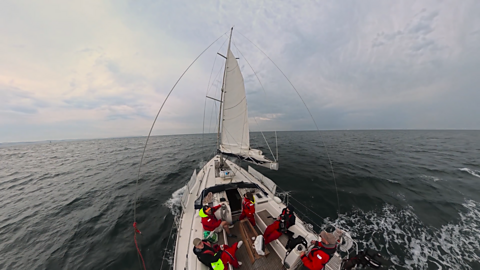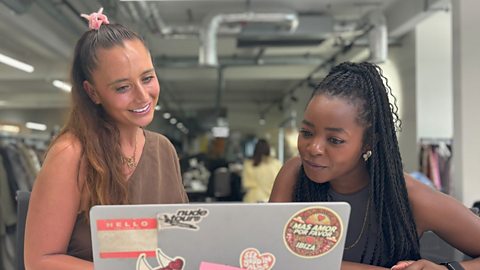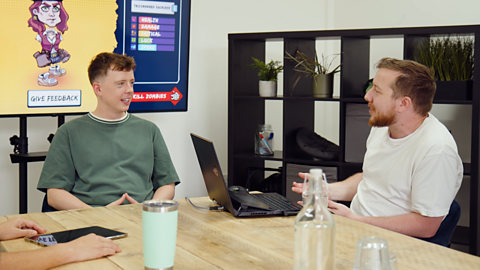This technology is really exciting. It allows us to learn things about species that we just don't know yet." - Rosie
Gareth Elis meets Dr Julie Oswald, a marine biologist, and Rosie Day, a PhD student biologist from the University of St Andrews, who have been recording dolphins off the south coast of England.
GARETH ELIS: Today, I'm meeting student biologist, Rosie, and Dr. Julie Oswald from the University of St. Andrews as we join with a team from the University of Plymouth to go and record dolphins off the south coast of England. Let's see how these recordings are used for conservation and what role AI has to play in it.
Julie, it's so nice to meet you. Tell me a little bit about yourself and your work.
JULIE: My work is mainly focused on developing tools that allow us to identify species in acoustic recordings. We need a lot of data, so we collaborate with universities and organisations around the world.
Once we can identify species in acoustic recordings, we use my system, called ROCCA, to identify the species that we're hearing in the recordings. I'm using a type of AI called Machine Learning. What machine learning is—it's basically the computer learning patterns in the data.
Once it's learned those patterns, it can make predictions. We tell the computer what species produced all the different whistles we give it, and it learns subtle differences between species.
Before, we used to make recordings, and if we didn't see the dolphins we were recording, all we could say was there was a dolphin there. But we could not say anything about what species. Different species behave in different ways and react in different ways to noise that we're putting into the ocean, or pollution, or fishing.
ROSIE: When you look at dolphin whistles, you can't actually tell the difference by eye - or at least we can't - between different species.
All over the world, we've got these recorders underwater that are recording lots and lots of data, but we can't always have someone there to see what species are around. We developed these things called classifiers that you can put these whistles into, and it will tell you what species it thinks it is.
We have this which is called a hydrophone, which is basically an underwater microphone, and it will record the sounds. We then feed it through this wire into a recorder, which is a bit like anything that popstars or someone would use to record their music.
JULIE: So we're going to deploy our hydrophone over the side.
ROSIE: Right now, we're hearing a lot of water going by the hydrophone. When the dolphins come close, we'll be able to hear them producing their whistle sounds.
GARETH: So, we're below deck now. Rosie, can you show me what happens to all the data once you've collected it?
JULIE: We'll open the data as a spectrogram, which is a depiction of sound in a visual image like this. In this red box I've just made now, that's a whistle. And I can play it for you if you like.
JULIE: So next, to create the training data for Rocca - because this is from a single species recording - we'll click 'Classify,' and it's got it right.
These are recordings taken from a bottlenose dolphin. The machine learning that we have now allows me to do things that I wouldn't have been able to do before and really take the next step in figuring out how dolphin communication works.
ROSIE: This technology is really exciting. It allows us to really learn things about whales and dolphins, and even other species that we just don't know yet.

Rosie's journey
The Bitesize Guide to AI team spoke to Rosie to find out more about her journey to using AI tools in conservation.
How has AI impacted your job?
The programs that I use for my work were possible to develop because of AI. This has allowed us to expand our knowledge of where different dolphin species occur and how they communicate, which can help us to develop better polices to protect them and the environments they rely on.
However, while AI can help conservation efforts, we need to be careful about interpreting the output of AI and make sure that we ground them in what we know of the natural world.
What have you always wanted to do in conservation that you couldn’t do before AI?
The ability to create catalogues of all the sounds a species of dolphin produces and then to compare those catalogues between populations and species is much more efficient and reproducible using AI. Additionally, AI is making it possible to detect much more subtle differences between species and populations and that helps us do a better job of identifying the sounds we detect in acoustic recordings.
Where do you see the AI going in the future?
Hopefully, with the use of AI and collaborating with other researchers, we can make our species classifiers (programs which can identify which dolphin species is whistling and therefore present in an area) more accurate, run more quickly and become more user-friendly, and therefore enable better conservation of these amazing animals.
What was your route into conservation research?
I grew up spending a lot of time in nature, rock-pooling and watching whales, as well as loving science in school. So, the only career path that made sense was to study marine biology. My undergraduate degree at the University of St Andrews lead me to working with Dr Julie Oswald and Prof Vincent Janik on their dolphin communication research which has resulted in my PhD researching ‘common dolphins’.
I was drawn into conservation through my interest in animals and the natural world, and, as a result, learning how humans have put them at risk. Conservation is a field where we both learn more about the species we study as well as developing better ways to protect them in this ever-changing world; and the combination of those aspects makes it a rewarding area to work in.


How the AI tool works
- Using an underwater microphone called a hydrophone, Julie and Rosie can record the sounds of dolphins underwater. The digital audio is analysed by an AI tool developed by Julie to log and identify which dolphin species are present in the area.
- This AI tool is called ROCCA (Real-time Odontocete Call Classification Algorithm). The ROCCA system analyses the dolphin sounds using a random forest classifier AI model. It can identify and classify dolphin species from their whistles and clicks.
- The AI tool learns subtle differences between species' sounds and provides almost real-time information on patterns of movement and the distribution of species around the South Coast. The findings are being used to investigate how the dolphins are affected by human activity. Pretty amazing stuff.

Did you know?
An 'odontocete' is an animal that belongs to the Odontoceti (toothed whale) family. It includes dolphins, porpoises, and killer whales. Through the hydrophone recordings and AI software, the University of St Andrews team can even identify individual dolphins - making the exciting discovery that dolphins have regional accents!


